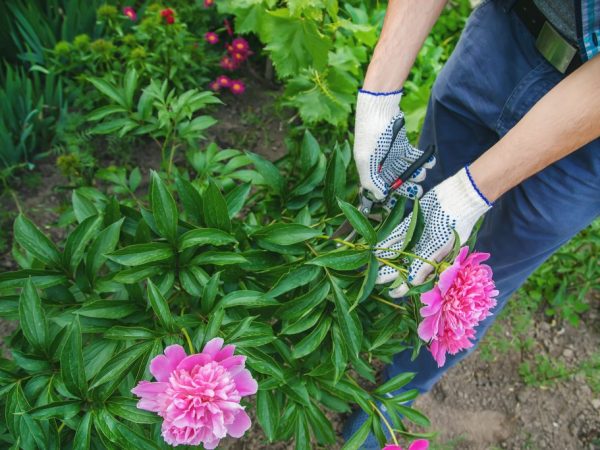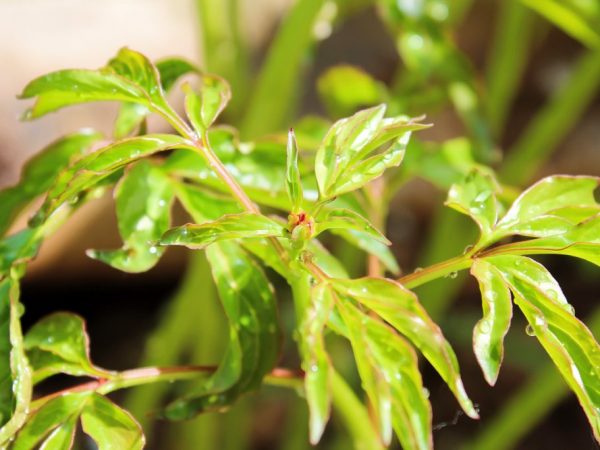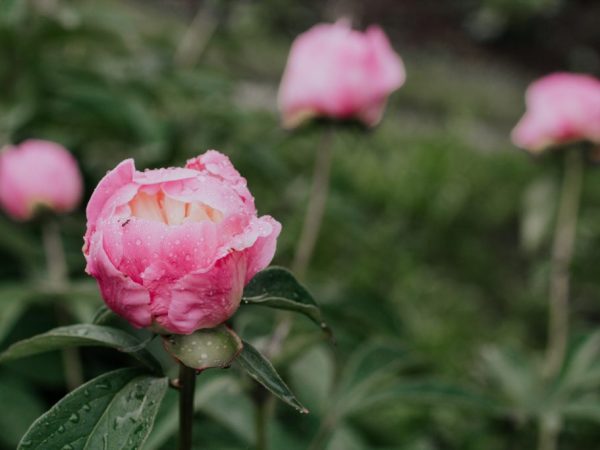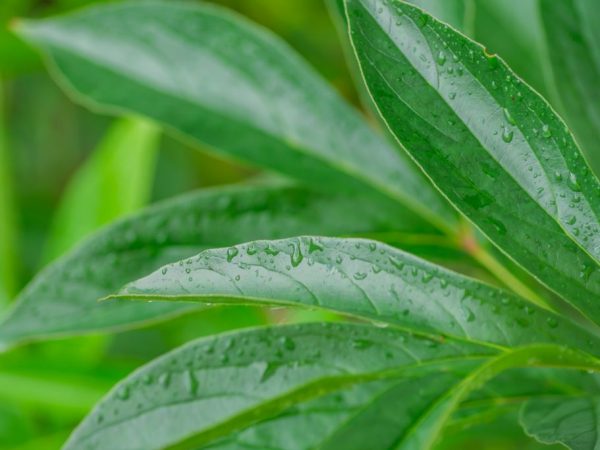How to care for peonies in autumn - preparing flowers for winter
Luxurious bushes of peonies, delighting in the spring with large flowers with a delicate aroma, are unpretentious. However, it is necessary to properly prepare for wintering. Autumn care includes several stages and begins long before the cold snap.

How to care for peonies in autumn - preparing flowers for winter
Basic procedures
Garden flowers, especially perennial flowers, often require vigilant attention. Peonies do not belong to them. Despite their gorgeous decorative appearance, they are quite unpretentious if planted in a well-chosen place, watered and fed on time.
At the same time, the plant is perennial, only once every 10-15 years does it need to divide the overgrown root and transplant to another place.
The period when more attention is paid to culture is autumn.
Watering
After flowering, the plant needs to replenish its strength, it takes 1-1.5 months. Then there is the laying of new buds for the next year, the accumulation of nutrients, and the strengthening of the root system.
For a successful renewal, regular watering is needed, it is carried out in the summer 1 time a week at the rate of 3-4 buckets under a bush.
For better absorption of moisture, you need to drip a groove around the perimeter. In elevated places, on the contrary, they create a small earthen roller so that the water does not spread.
In autumn, watering should be more abundant so that the peonies go for the winter with a supply of moisture. The best time to hydrate is after sunset.
Important: it is better to water along the periphery, where the small suction roots are located. They are not directly under the stems.
Top dressing
Preparing peonies for winter includes a feeding stage: the plant needs mineral and organic substances.
Proper nutrition will create a reserve of strength, in the spring the bushes will grow faster, the flowering will be abundant and long-lasting.
Fertilization starts in the 3rd year. Term - 2 months before pruning, from the first days of September.
Mineral components
Nitrogen is left in the spring, and in the fall, emphasis is placed on phosphorus-containing preparations.
- More often they give preference to superphosphate and phosphate rock. When the soil is acidified, add chalk, limestone, dolomite flour.
- Potassium fertilizers, in particular, chloride and potassium sulfate, will help peonies survive severe frosts. They strengthen the roots, increase the plant's resistance to unfavorable natural conditions.
- The multicomponent remedy "Kemira-Autumn" based on phosphorus and calcium has proven itself perfectly.
Organic
These fertilizers are environmentally friendly and are quickly absorbed from the soil.

Autumn feeding is necessary
Poultry and cow manure, peat, vermicompost, compost, green manure - they are laid out under the bush at the rate of 2-3 kg per 1 sq. M.
Fresh manure and bird droppings are not suitable, an infusion is prepared from them: 1 bucket of material for 10 buckets of water, insist for 2-3 days and again dilute in water at a ratio of 1:10.
Wood ash reduces acidity, prevents the appearance of pests, is used both in solution or infusion, and in dry form as a powder for the root zone.
Pruning
The quality of flowering of the bush and its health depend on compliance with the terms and technology.
- Reducing the green mass too early will weaken the peonies;
- Later, it will create the prerequisites for rotting and the appearance of fungal infections.
The optimal time is considered the moment when the leaves began to turn red, fall off, and the stems tend to the ground.
Important: trimming is carried out only with a sharply sharpened and disinfected instrument. After processing 1 bush, the disinfection of the knife or pruner is repeated, otherwise there is a risk of transferring a possible latent disease to another plant.
In tree peonies, the skeletal branches are not touched, in herbaceous peonies they leave a stump of 1-2 cm. Plant residues are carefully removed and burned in a separate place.
Pest control
Bronzovki - they are harvested by hand, and the earth under the bush is watered with an insecticide solution in the evening.
Gall nematodes - their appearance predicts the death of the peony, you have to dig it up and burn it in order to preserve the rest of the flowers.
Aphid - destroyed by Fufanon.
Ants, ticks, thrips - do not like chemicals and quickly leave the battlefield after 1-2 sprays.
Diseases and treatment
Rust - was named for its external signs. Uneven brown spots with pads full of spores appear on the plant, they can be orange or red.
Diseased leaves and stems are cut and burned, and the treatment is carried out with Bordeaux liquid.
Gray rot - it is dangerous because it develops quickly and affects all parts of the flower.
- Outwardly, you can recognize it by the dried buds and leaves with a characteristic grayish bloom.
- The second sign is the appearance of brown spots around the stem at the root collar.
For prophylaxis, Bordeaux mixture is used, for treatment - Tiram's suspension.
Powdery mildew - visible immediately on the white bloom on the leaves and buds. There is no particular harm from it, except for a spoiled appearance.
Spraying with a mixture of laundry soap and soda ash is required. Processing is carried out twice with an interval of 10 days.
Verticillary wilting - manifests itself during the flowering period. To confirm the diagnosis, it is enough to cut off any stem and look at the vessels.

Inspect plants periodically for disease
If they darkened, then an urgent need to dig up and burn the plant, saving those that are nearby. The disease cannot be cured, but it spreads very quickly through neighboring peonies.
The place from which the diseased bush was removed is carefully dug up, covered with bleach or spilled with formalin. This year, nothing can be planted on this site.
Flexible - the reason for the appearance lies in high humidity with a lack of heat. At the first signs, diseased fragments are removed and burned, spraying with copper-containing preparations is carried out, the frequency of watering decreases, and loosening becomes more frequent.
In autumn, for preventive purposes, the green mass is treated with a Bordeaux mixture. Activities are necessary to maintain the health of the bush for the next year.
When to start preparing for winter
Preparation is especially important in regions where there is little snow and the frosts are long and very severe.
To make the peonies comfortable in winter, the roots must be protected, and the branches must be cut in a timely manner.
Before sheltering, you need to check whether all fragments of stems and leaves have been removed and destroyed. Some pests are able to calmly tolerate cold weather, hiding behind plant debris.
In different areas, the timing of planting or the beginning of autumn preparatory work may differ by 2-4 weeks.
In outskirts of Moscow
The first stable frosts usually occur at the very end of October. It is necessary to complete all work on the preparation and covering of the bushes 10-14 days before them.
This means that the bulk of the worries will fall on the end of September or mid-October.
In the Urals
In this region, all work will cease by mid-October, as the region is colder and more windy. Bushes need to be covered not only from above, but also to mulch the root zone.
Additional covering with film or special material with fixation is allowed.
In Siberia
In the northern regions, frosts start 2 weeks earlier, which means that by the beginning of October the summer cottage season is practically over.
An important condition in this region will be to shelter peonies only in dry weather, the use of film is not recommended, it is better to form an additional layer of grass or spruce branches.
In the Leningrad region
Sometimes winter is late and warm days are possible as early as early November. Nevertheless, it is better not to delay and finish the season by the last days of October.
Features of preparation of different types

Peonies for the winter must be covered
The list of preparatory measures depends on the type of plant and its variety, since the level of frost resistance is different for them, as are the requirements for care.
Tree-like
More than 500 varieties are known. The most popular are: Sapphire, Coral Altar, Green Jade, Delaway, Lemoine.
They are tall (up to 200 cm), the structure of the shrub is powerful, the branches are fragile. They do not bend, but immediately break, so the first concern is to keep them intact.
First of all, all the leaves are removed when the air temperature drops to 3-5 °. The branches are divided into how many bundles and fixed. The root zone is mulched with peat, the branches are covered with non-woven material, spruce branches.
Young bushes are covered with an inverted box or bucket to prevent the branches from breaking under the weight of the snow that has fallen. Regardless of the variety, color and size of the buds, autumn care will be the same.
Herbaceous
They have a large number of varieties. The flowers can be very simple or densely double.
Most often purchased for planting: Avangard, Iceberg, Aza Gray, Aquarelle, Bakai Bell, Victoria, Varenka, Diana, Mercedes.
The culture is cut almost at the root, it is very easy to cover the remaining parts of the plant. It is enough to stretch the covering material over the stumps, insulate with peat or humus. After the snow falls, a snowdrift is thrown over the place of growth of the bush.
Ito hybrids
They are the most stable, bred to grow in cold regions, so they do not require additional protection in warm winters.
The varieties are not afraid of frost: Bartsella, Border Charm, Viking Full Moon, Garden Treasure, Dark Eyes, Julia Rose, Kellis Memori.
When the winter is too harsh, the shelter is carried out according to the general principle.
Planting peonies in the open field means that they need to be carefully covered in the fall so that they can safely survive the winter.
Typical mistakes gardeners
- Pruning any kind of peony too early will weaken the plant.
- Preservation of trimmed fragments provokes the appearance of fungal diseases.
- Lack of nutrients leads to a reduction in the number of buds and a change in their size downward.
- Nitrogen fertilization in autumn causes unnecessary growth of green mass and weakens the roots.
- Peonies left without shelter can freeze out in a harsh winter.
Bright, showy and unpretentious peonies need minimal care and autumn preparation for winter. Top dressing, pruning and covering the bushes on time guarantees a lush flower bed with your favorite flowers for the next year.

